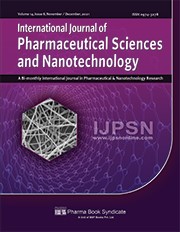Poly-Herbal Formulations: Current Status and Future Perspectives for Treatment of Various Complications
DOI:
https://doi.org/10.37285/ijpsn.2021.14.6.1Abstract
In customary medication, the greater part of infections has been treated by reveling of plant or plant items. As indicated by the Ayurveda individual herbs are deficient to accomplish an ideal restorative impact. To conquer this issue numerous spice structure in certain proportion is utilized that will give a superior restorative impact in better manner with decreased harmfulness. To grow such mediation, current examination will address about polyherbal formulation uses and its outline in treatment of different diseases and ailments. Home grown medications have existed worldwide since long time ago, therefore they bear history, and they were utilized in Chinese, Egyptian and Indian medications for different treatment. This review primarily centers around significance of polyherbal and its clinical importance.
Downloads
Metrics
Keywords:
Polyherbal formulation, Active principles, Ayurvedic system, Clinical significance, Antibacterial activityDownloads
Published
How to Cite
Issue
Section
References
Adeyemi OS et al., (2012). Yoyo Bitters, a polyherbal formulation influenced some biochemical parameters in Wistar rats. Journal of Basic Clinical Pharmacology. 23(4): 135–8.
Annie shirwaikar et al., (2008). Standardization of polyherbal formulation, Pharmacognosy Magazine. 4(13): 65-69.
Arrey Tarkang P et al., (2014). In vitro antiplasmodial activities and synergistic combinations of differential solvent extracts of the polyherbal product, Nefang. Biomed Res International. (4):835013.
Bhav Mishra, (2018). Bhavprakash Nighantu. Pg. 513.
C. S Barik et al., (2015). A review on Therapeutic potential of polyherbal formulations, International journal of ph.Sciences and drug research. 7(3): 211-228.
C. S Kandasamy et al., (2011). Antimicrobial activity of the crude drugs and the polyherbal formulation (RVSPHF567) by Standardized cup plate method. International journal of pharmaceutical sciences and research. 2(10): 189-195.
Devaraj VC et al., (2011). Hepatoprotective activity of Hepax-A polyherbal formulation. Asian Pac J Trop Biomed. 1(2):142–6.
Divya KK et al., (2012). Evaluation of in vitro antioxidant capacity and reducing potential of polyherbal drug Bharagyadi. Ancient science Life. 32(1): 24-28.
Dr.KM Nadkarni, (1954). The Indian Materica Medica. Vol(1): 480-484.
Duttagupta DS et al., (2015). In-vitro antioxidant activity of a polyherbal menopausal formulation: ovoutoline tablet. World Journal of pharmaceutical sciences. 4(05): 1001–8.
Frawley D, Ranade S (2000). Ayurveda, Nature’s Medicine. Wisconsin: Lotus Press.
Gopumadhavan S et al., (2005). Antihistaminic and antianaphylactic activity of HK-07, a herbal Formulation. Indian J Pharmacology. 37(5): 300-303.
Jyothi MJ et al., (2012). Formulation and evaluation of poly herbal hand wash. International journal of pharmacy. 2(2): 39-43.
Kajaria DK et al., (2010). Evaluation of in vitro antioxidant capacity and reducing potential of polyherbal drug- Bharangyadi. Ancient Science Life. 32(1): 24-8.
Krishnamoorthy JR et al., (2015). An Overview of Management of URTI and a Novel Approach Towards RSV Infection. Respiratory Diseases. 179-194.
Kruti pandya et al., (2011). Phytochemical screening & evaluation of antibacterial activity of polyherbal formulation, Indian global journal of ph.Sciences. 1(3): 206-218.
Mathew L, Babu S, (2011). Physiotherapy in India: Transition of tradition to technology. Current botany. 2(5): 26-30.
Ogbonnia SO et al., (2010). Effect of a poly-herbal formulation, Okudiabet, on alloxan- induced diabetic rats Nwakakwa N Department of Pharmacognosy, Faculty of Pharmacy, College of Medicine Campus, Idi- Department of Clinical Pharmacy and Biopharmacy, Faculty of Pharmacy, Co.
Oreagba IA et al., (2011). Herbal medicine use among urban residents in Lagos, Nigeria. BMC Complement Altern Med.
Parwez Alam et al., (2016). Development of polyherbal solid dosage formulation using Amla Withania and Tulsi extract in different ratio, World Journal of Pharmaceutical Research. 5(9): 1632-1640.
P. H sharma et al., (2015). Development and evaluation of polyherbal tablet triturate for oral hygiene, International Journal of Pharmacognosy and Phytochemical Research. 7(3): 424-430.
Pluemsamran T et al., (2013). Redox Mechanisms of AVS022, an Oriental Polyherbal Formula, and Its Component Herbs in Protection against Induction of Matrix Metalloproteinase-1 in UVA-Irradiated Keratinocyte HaCaT Cells.
Qadri NM et al., (2011). Evaluation of Herbal Drug for Hypoglycemic Activity in Normal, Hyperglycemic and Alloxan-Induced Diabetic Rabbits. Pakistan J Chem. 1(1): 32–7.
Rakesh K. Sindhu et al., (2019). Formulation development and antimicrobial evaluation of polyherbal so3, Plant Archives. 19(2): 1342-1346.
Rohini, (2018). Bhaishajya Ratnavali. Pg. 623.
Rohit kumar et al., (2018). In vitro Antioxidant and antimicrobial activity of polyherbal formulation, International Journal of Green Pharmacy. 80-84.
Rui-zhi F et al., (2013). The efficacy and safety of Baoji Tablets for treating common cold with summer-heat and dampness syndrome: study protocol for a randomized controlled trial. Trials:14(440): 1-8.
Subramani Parasuraman et al., (2014). Polyherbal concept of ayurveda. Pharmacognosy Review. 8(18):73-80.
Shri Balakrishna Acharya et al., (2018). Formulation, evaluation and antibacterial efficiency of water based herbal hand sanitizer gel. bioRxiv DOI: 10.1101/373928
Singh. G, (2020).Charak Samhita Chikitsasthan, chapter 7.
Suresh Kumar Dev et al., (2019). Antimicrobial, anti-inflammatory and wound healing activity of polyherbal formulation, Biomedicine & Pharmacotherapy. 111: 555-567.
T.E wallis, (2004). Textbook of pharmacognosy, 5th edition, CBS publishers, New Delhi: 136-138.
The Ayurvedic pharmacopoeia of India. Part1, (1989). Vol(1): 4-5.
United States Pharmacopoeia 27. Rockville, MD.U.S Pharmacopoeia Convention: 1685, (2004).
Vinod SB et al., (2012). Effect of madhumeh an antibiotic polyherbal formulation on carbohydrate metabolism and antioxidant defense in Streptozotocin-Nicotinamide (STZNICO) induced diabetic rats. International Journal of Pharmaceutical Life Science 3(5): 1690-1695.
Yang Z et al., (2013). Anti-Inflammatory Activities of a Chinese Herbal Formula IBS-20 In Vitro and In Vivo. Evidence Based Complement Altern Medicine.1–12.






